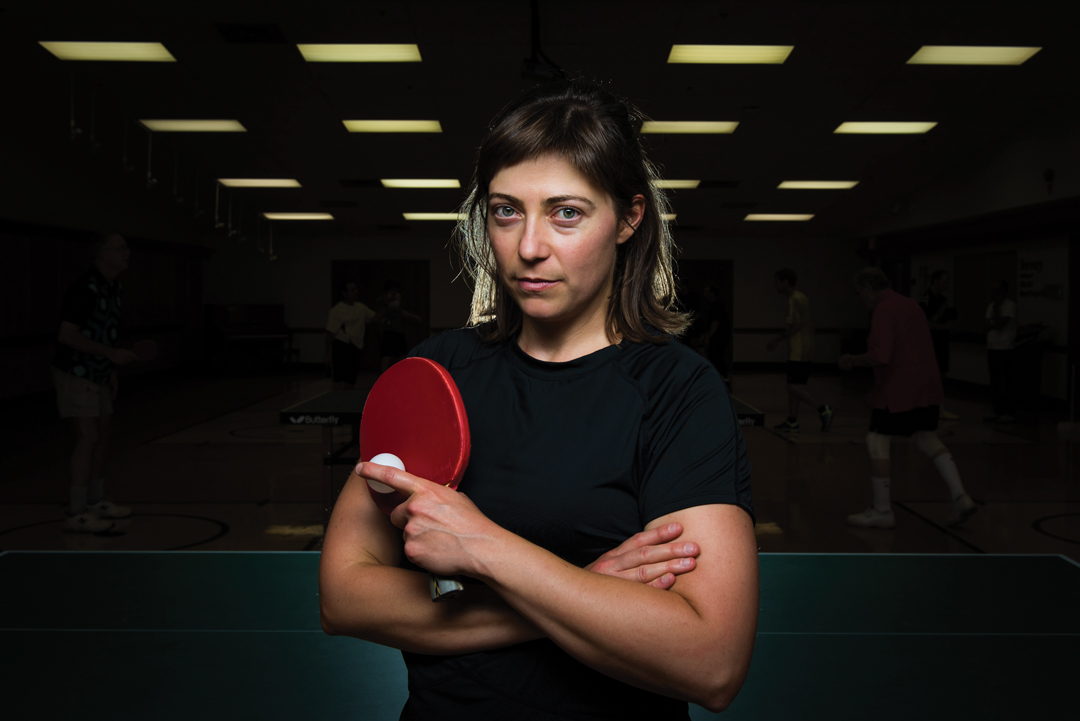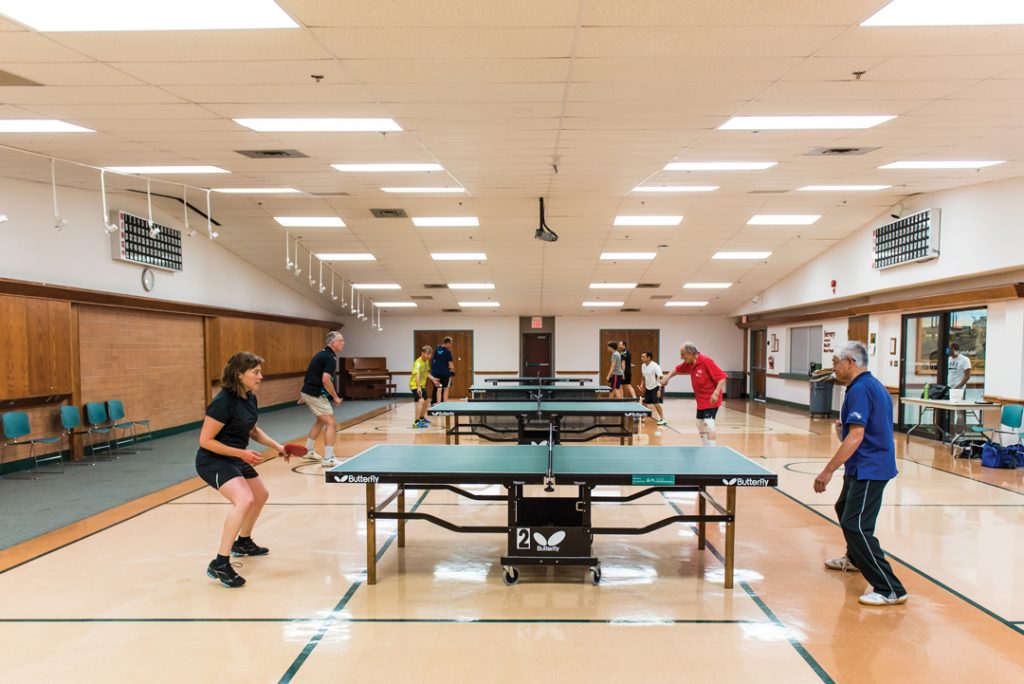BUG ACE
AAFC ENTOMOLOGIST OUTSMARTS HER OPPONENTS AT THE TABLE AND IN THE FIELD
BY ELLEN COTTEE
A competitive table tennis player, a Winnipeg Blue Bombers fan and now a plant entomology researcher at Agriculture and Agri-Food Canada’s (AAFC) Lethbridge Research and Development Centre, Haley Catton is not one to shy away from a challenge.
Growing up near Winnipeg, MB, Catton never thought she would leave her home province. Her love for Manitoba’s farm culture and her passion for being outside in nature led her to pursue her B.Sc. in agriculture and M.Sc. in plant science at the University of Manitoba. Catton, however, eventually did leave Manitoba for British Columbia—she worked on her PhD in biology at the University of British Columbia’s Okanagan campus in the winters and conducted research at AAFC’s Lethbridge Research and Development Centre in the summers. When she finished her PhD research, AAFC hired her on full time.
Only six months into her new job, Catton couldn’t imagine working anywhere else. “I can’t believe how lucky I am to actually work here now, permanently,” she said. “This is a dream come true.”
GrainsWest: How did you get from plant systems to field crop entomology?
Haley Catton: My PhD was a plant-insect interaction project. I was studying a biological control insect that was released to control a weed, so the insect in that case was a good guy, and I was studying the impact of that insect on the weed. Crop entomology is the same thing—you’re studying the impact of insects on plants, but in this case the insects are the bad guys … Basically, the kind of research I do is figuring out what the insect is vulnerable to, whatever its Achilles heel is in its life cycle, and same thing with the plants. It’s kind of like being a private investigator, asking “Where is this insect vulnerable? How can I control it?” It involves really getting up close and personal with the insects and the plants. I love that.
GW: What’s the most interesting insect you’ve studied?
HC: Well, my PhD insect was my favourite. It’s called Mogulones crucifer and it’s fascinating because it was released in Canada as a biological control insect, but not in the United States. They outlawed it in the U.S., so in Canada the insect is a good guy, but in the U.S., where the insect is travelling naturally, it’s a bad guy. There are a lot of cool social issues that come along with that project, and the insect is very effective, which is awesome. It’s like a seek-and-destroy insect. It finds its weeds … eats them and kills them. My PhD was about how it affects its target weed and also non-target plants. There was some concern that it might affect some related non-target plants, but we didn’t find any evidence for that in my investigation, which was the biggest of its kind. It’s good news.
GW: What solutions can be investigated in controlling pest populations that are harmful to crops?
HC: The first thing is you need to know the biology of the pest, the life cycle, where it lives, when it’s active, what kind of damage it does. For some pests that’s already known, and for some we don’t know that yet. That’s step one, figuring out what the pest is and how it behaves … That usually takes years because you need to go through a couple generations to see how fast they grow, how many eggs they lay.
I’m working on integrated pest management, which means using a number of different approaches to control a pest. You may use something like resistance crop varieties and combine that with maybe planting your crop a little bit earlier than normal, and, if you have to, use insecticide or maybe biological control—it’s not just relying on one method. Integrated pest management is about using a number of tools to hit ’em where it hurts, from multiple angles.
Another thing I will be doing once I get more into the program is economic thresholds, which means you might have a low number of pests in the field and if you spray the field, it will cost you money for the spray. But the pest wouldn’t have cost that much in damage if you had just left it. We want to figure out how much damage you need before it becomes economically worth it to spray … If the insect isn’t doing much damage, then you’re wasting money by spraying. Not only that but you’re killing all the insects in your field and there’s a whole bunch of beneficial ones in there too, like natural predators and even spiders. So you don’t want to spray those guys out because they’re the ones [who are] going to be eating any pest insects you have. We try to determine when it’s smart to spray—when it’s worth it.
GW: Sustainability is a big topic for producers right now. How does crop management come into play with sustainability?
HC: That’s huge. In talking about integrated pest management, that’s very related to sustainability because it may not be sustainable to only use insecticide. Insects can develop a resistance to insecticide, so if you use multiple strategies … then you’re going to slow down any resistance in the insects. That makes our current practices sustainable in the long run. If we only use spray, then we’re going to lose the power of the spray, and then what are we going to do? Integrated pest management is the best way we know to go forward sustainably.
I like the term “life hacking,” and this is kind of like hacking biology. We’re trying to find out what is the hack we can use on this insect population—how can we control it in the best, quickest way? To do that, you have to know your system inside and out.
GW: Rumour has it you are a competitive table tennis player, yes?
HC: Yes! That’s another thing about Lethbridge I love. There’s a table tennis community here. At the research centre there are tables downstairs. We play at lunch, and also there’s a club full of people who will go up to tournaments in Calgary and Edmonton and across the Prairies, and I love playing with them.
GW: You like the challenge of table tennis. Is that similar to the challenge you have investigating these pests?
HC: Yes! A lot of table tennis is about reading your opponent, knowing what they are going to do before they do it, and your job is to try to put them off balance and make them vulnerable. Maybe you shoot it to one side of the table, get them a bit off balance, and then shoot it to the other side right after so that they can’t get to the ball. Studying the insects is the same thing. You’re studying your opponent, those insects, and saying, “Okay, how can we make them vulnerable? What can we do to put them off balance and make them vulnerable to a control method?” And you’re reacting. When they do something, you have to react, and hopefully you set them up so that you can win the point. And that’s a challenge that I really love working on. It does sound kind of cheesy, but I’m serious about it. I love reading my opponent and positioning myself where I can score the point.
GW: What are the next challenges for you at AAFC?
HC: I’m always looking for new project ideas. I want to hear from producers what they think the priorities are. If they have a burning question, it could turn into a research project for me. So I want to get out there and I have been talking to people, hearing what they think and what their concerns are for cereal crops. This is a service, and I want to serve producers. I’m a real team player—I want to do the research that needs to be done.








Comments